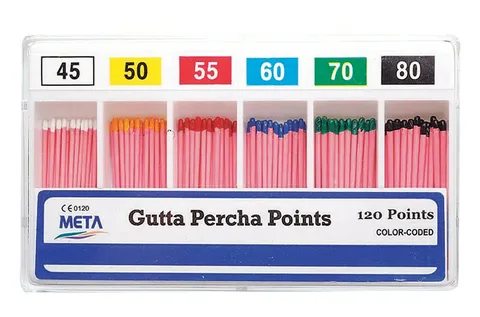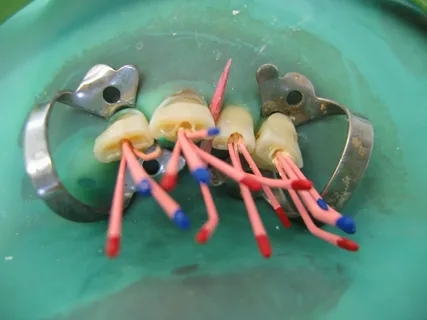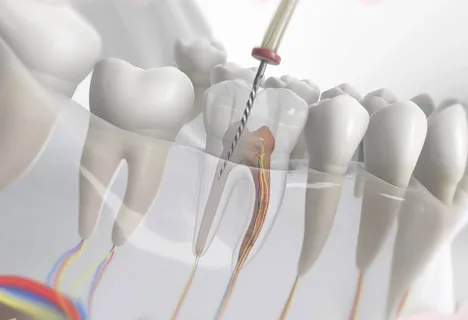General characteristics of fillers in dentistry
Machine translation
Original article is written in ES language (link to read it), RU language (link to read it).
Fillers are solid fillers used for obturation of root canals, made in the form of pins. Pins are produced in various sizes, and they are selected based on the length and diameter of the channel, taking into account ISO standards. Due to their shape, the pins fit tightly to the canal walls, have minimal shrinkage, and are easy to use.
Learn more about root canal obturation in the webinar Irrigation and root canal obturation .
Gutta-percha
Gutta-percha is a natural material, 60% of which has a crystalline structure at room temperature, the remaining proportion is amorphous.
Advantages of the material
Does not have a toxic or irritating effect on the body.
Has plasticity.
Chemically inert.
X-ray contrast.
When finished in the form of a pin, it does not shrink.
Reliably fills the root canal over a long period of time.

Figure 1. Classic gutta-percha points.
Types of gutta-percha pins
Gutta-percha, used for endodontic treatment, comes in the form of pins that differ in taper and shape.
The types of pins are as follows:
“basic”, they are used as a central pin;
“auxiliary”, used for lateral compaction.
Basic, standard gutta-percha pins in their size and taper meet ISO requirements for cutting instruments and are coded with the same type of color marks.
Additional or auxiliary pins come in different sizes, including:
ultra-thin;
very thin;
thin;
average;
big.
Gutta-percha pins are made by hand or machine. The manual method guarantees maximum calibration accuracy when making pins. Machine production does not allow for accurate calibration. It is worth noting that today the vast majority of gutta-percha points are produced using the machine method.

Figure 2. Filling canals using the lateral condensation method.
Material properties
Gutta-percha has the properties of polymer compounds, one of which is viscoelasticity. When molten gutta-percha is rapidly cooled, it returns to its crystalline “α-form.” This quality has found application in the manufacturing process of most brands of gutta-percha on the market.
If you take chilled gutta-percha and gradually heat it above 65 ° C, but this must be done very slowly, no more than 0.5 ° C per second, the material will turn into the “β-form”, which is characterized by fluidity and excessive softness, not suitable for filling channels.
The crystalline phase of gutta-percha is represented by the following forms:
a-phase;
b-phase.
They differ in the spacing between the repeating structural components and the shape of the monomer. The natural material is the a-phase, and processed gutta-percha is the b-form, which is what is used to create endodontic posts.

Figure 3. Obturation with gutta-percha points.
When heated to 46 °C, the material passes from the b-phase to the a-phase. If heating continues further and reaches a temperature of 55–60 °C, then the b-phase turns into the amorphous state of the material. In the case of gradual cooling, the substance again acquires the crystalline a-phase, but with simple uncontrolled cooling, gutta-percha passes into the b-form.
Gutta-percha easily dissolves under the influence of chloroform and fluorothane, and softens when heated to 64 °C.
Composition and characteristics of raw materials for the manufacture of gutta-percha points
Endodontic pins for canal obturation include the following components:
about 20% gutta-percha, which guarantees stability of volume, shape, and elastic properties of the pin;
zinc oxide about 66%, plays the role of a filler;
the share of sulfate salts of various metals accounts for about 11% of the mass of the material; they provide radiopacity of the pins;
approximately 3% of the composition is plasticizers necessary to give the pins good handling qualities;
biological dyes, other components necessary to prevent oxidation.
Advantages of the material
bioinertness;
weak antibacterial effect;
ease of insertion into the canal, ease of removal if necessary;
no shrinkage;
moisture resistance;
radiopacity;
does not change the color of the tooth.
Disadvantages of the material
gutta-percha point can only be subjected to disinfection, sterilization is impossible;
without additional sealing compositions it is impossible to achieve maximum compaction in the channel; the problem is solved with the help of sealers;
there is no adhesion to dentin;
thin pins are excessively flexible, which makes filling narrow channels difficult;
there is no feeling of manual emphasis when working with thin pins; sufficient rigidity is typical for pins starting from size 35;
At the stage of preparation and disinfection, gutta-percha points are easily stretched, which complicates checking the working length.
Working method
The most popular method of disinfecting gutta-percha is treatment with sodium hypochlorite, and then with ethyl alcohol, the latter allows you to get rid of sodium hypochlorite crystals that can negatively affect the sealing of the canal obturation.
The gutta-percha pin is placed in the canal and is subjected to a certain condensing pressure. It is impossible to compress gutta-percha; therefore, compression or condensation when performing obturation does not imply compression of the material, but maximum compaction of the pins themselves so that they fill the canal as much as possible.
For better adaptation of gutta-percha in the canal space, you can use heating or dissolving the material. Both methods cause slight shrinkage of gutta-percha after curing, which does not exceed 1-2%, but allows the material to be significantly compacted. Presumably, this shrinkage can be leveled out if the gutta-percha is heated to more than 45 °C. For these purposes, it is recommended to use devices that help control the heating temperature.
Gutta-percha undergoes oxidation under the influence of light and air, which causes brittleness. Recommendations for storage: dry, cool place, away from direct sunlight.
Gutta-percha cannot be used as an independent filling material, since the material is not capable of adhesion to dentin. To perform canal obturation, a sealer will be required.

Figure 4. Apparatus for obturation of root canals.
Filling methods using gutta-percha
pre-heating of gutta-percha, already heated material is placed into the canal;
the use of an endodontic obturator - a thermophile system, it is a plastic or metal rod around which gutta-percha is located;
introduction of chilled gutta-percha followed by warming and softening;
the use of gutta-percha and silver pins, the latter have radiopacity, a bactericidal effect, and are durable.
Hybrid materials
Numerous experiments conducted to facilitate the filling process and improve its quality have led to the creation of various hybrid materials. The entire variety of hybrid materials today is represented by a-gutta-percha due to its low melting point.
Examples of systems based on titanium and silver pins in combination with thermoplasticized gutta-percha:
Ultrasfil;
Quickfil;
Successful;
ThermaFil Plus;
SoftCore.
Quickfil system
It is based on a titanium rod coated with a layer of a-gutta-percha. When inserted into the root canal, the titanium rod rotates, the gutta-percha begins to heat up, becomes soft and tightly seals the canal lumen. The titanium rod is not removed from the canal; it remains there, performing the function of a central pin. Used in conjunction with hardening sealer.

Figure 5. Hybrid material.
Successful system
Before insertion, a titanium or silver pin is covered with heated a-gutta-percha, then it is inserted into the canal. Within a few minutes, a-gutta-percha hardens. The pin cannot be removed from the canal.
ThermaFil Plus and SoftCore
These systems are equipped with a rigid rod on which a-gutta-percha is applied; the rod is placed into the channel under pressure. Possible materials for manufacturing rods for these systems:
plastic,
stainless steel,
titanium.
First, a-gutta-percha is heated in a special device, similar to an oven, where a halogen lamp is located, the material is used together with an endosealant. The high efficiency of the system is due to the fact that molten gutta-percha, placed under pressure, guarantees high-quality three-dimensional obturation of the canal along the entire length.
More relevant information on this topic at the webinar Black and white aesthetics in endodontics. Obstruction problems .





